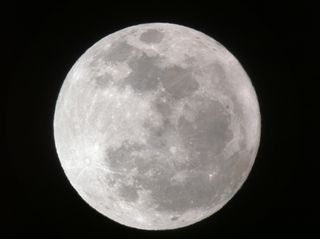The Far Side of the Moon Has Phases and Now You Can See 'Em (Video)

A new video from a NASA satellite orbiting the moon brings the phases of the far side of the lunar body into the light.
The phases of the moon — full moon, new moon, crescent and everything in between — also occur on the side facing away from Earth, according to data gathered by the NASA's Lunar Reconnaissance Orbiter (LRO). As the moon and the Earth move together around the sun, both sides of the planet's natural satellite experience phases of light and dark. You can watch the LRO video featuring lunar data and images.
The reason Earth only sees one side of the moon is that the two objects spin in a certain way relative to one another. The moon rotates as it orbits around the Earth, but its orbit and its rotation are matched, causing only one side to ever face the Earth — a phenomenon called tidal locking. [Moon Master: An Easy Quiz for Lunatics]
Launched in 2009, NASA's LRO probe has imaged the far side of the moon in gorgeous detail. The phases of the moon on the far side differ from the familiar phases on the Earth-facing side. In one view, the far side of the moon is nearly full, at a time when skywatchers on Earth would see a waning crescent moon almost entirely covered in shadow.
The LRO video was created at NASA's Scientific Visualization Studio at the Goddard Space Flight Center in Greenbelt, Maryland. Some of the footage used in the new video was taken by LRO with a telescopic lens, causing the Earth to appear larger than life behind the moon (this is also accomplished with computer software). Another view taken with wide-angle lens reduces the Earth's apparent size in the background.
Images of the far side of the moon also reveal its very different appearance compared to the side facing the Earth. Most notably, the far side has fewer dark splotches, called maria, which are pools of cooled lava. Maria are what create the familiar illusion of a "face" on the moon, leading to the fable of "the man in the moon."
The far side of the moon is heavily speckled with craters of many different sizes; It has even more craters than the near side. Scientists suspect that the lava that created the dark maria spots covered up many of the craters on the near side. The slightly darker region in the lower third of the far-side disk is part of the South Pole-Aitken basin, one of the largest and oldest impact features in the solar system, according to NASA.
Get the Space.com Newsletter
Breaking space news, the latest updates on rocket launches, skywatching events and more!

The first images of the far side of the moon were captured by the Soviet probe Luna 3, in October 1959. The images captured by Luna 3 were of low quality, but provided the very first glimpse at the unseen side of the Earth's only satellite.
The $540 million LRO probe has returned hundreds of terabytes of data about the far side of the moon. In its first year alone, it delivered 192 terabytes of information, which is more data than is stored in all the printed materials in the Library of Congress.
Follow Calla Cofield @callacofield. Follow us @Spacedotcom, Facebook and Google+. Original article on Space.com.

Join our Space Forums to keep talking space on the latest missions, night sky and more! And if you have a news tip, correction or comment, let us know at: community@space.com.

Calla Cofield joined Space.com's crew in October 2014. She enjoys writing about black holes, exploding stars, ripples in space-time, science in comic books, and all the mysteries of the cosmos. Prior to joining Space.com Calla worked as a freelance writer, with her work appearing in APS News, Symmetry magazine, Scientific American, Nature News, Physics World, and others. From 2010 to 2014 she was a producer for The Physics Central Podcast. Previously, Calla worked at the American Museum of Natural History in New York City (hands down the best office building ever) and SLAC National Accelerator Laboratory in California. Calla studied physics at the University of Massachusetts, Amherst and is originally from Sandy, Utah. In 2018, Calla left Space.com to join NASA's Jet Propulsion Laboratory media team where she oversees astronomy, physics, exoplanets and the Cold Atom Lab mission. She has been underground at three of the largest particle accelerators in the world and would really like to know what the heck dark matter is. Contact Calla via: E-Mail – Twitter
